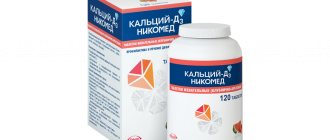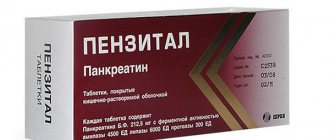Complivit Calcium D3 forte
Double 3 dose of vitamin D3 and calcium to strengthen bones in adulthood!
- Contains double3 dose of vitamin D3 and calcium for better absorption in adulthood1
- Helps strengthen bones, maintain muscle strength for beautiful posture and easy gait
- Designed for the prevention and complex therapy of osteoporosis
To ensure the absorption of calcium and metabolic processes in bone tissue, vitamin D is required. The content of vitamin D in the body depends on many factors. Vitamin D synthesis occurs in the skin under the influence of ultraviolet rays and depends on skin pigmentation, latitude of the region, length of day, time of year, weather conditions and the area of skin not covered by clothing. In winter, in countries located at northern latitudes, most of the ultraviolet radiation is absorbed by the atmosphere and the synthesis of vitamin D in the skin is practically absent8.
Vitamin D is an important vitamin that is involved in regulating many other processes in the body 1,4-8. It is involved in the regulation of muscle tone, in maintaining the body's antitumor defense, glucose and insulin metabolism, blood pressure levels, and thyroid function. Another important function of vitamin D is its participation in maintaining immunity. Vitamin D is a potential immunomodulator and is involved in the regulation of the body's immune response to various infectious diseases.
With age, after 50 years, there is a decrease in the skin's ability to produce vitamin D. Combined with decreased sun exposure, this leads to a decrease in serum vitamin D levels, which contributes to the development of osteoporosis and, as a result, an increased risk of fractures.
Osteoporosis is the leading cause of fractures in men and women over age fifty and is a growing problem. Every third woman over the age of 45–50 and almost half of all men and women over 65 are faced with the problem of brittle bones. And the frequency of vitamin D3 deficiency among the Russian population reaches 83%.1
According to the latest recommendations,2 people over 50 years of age need to take 1000-1200 mg of calcium and 800 IU of vitamin D3 to prevent osteoporosis and its consequences.
Just two Complivit® Calcium D3 forte tablets contain 1000 mg of Calcium and twice as much Vitamin D3: 800 IU. To replenish the daily requirement of calcium and vitamin D3, as well as for the prevention and complex treatment of osteoporosis and its complications (fractures).
Compound
Calcium 500 mg (as carbonate) + 400 IU Vitamin D3
Release forms
Chewable tablets with mint flavor, No. 30, No. 60, No. 100, No. 120
Indications for use
Prevention and complex therapy of osteoporosis and its complications (fractures).
Prevention and treatment of calcium and/or vitamin D3 deficiency.
Complivit® Calcium D3 forte is approved for use in adults and children over 3 years of age.
Complivit Calcium D3 forte tablets chew mint N30
Registration Certificate Holder
OTCPHARM (Russia)
Dosage form
Medicine - Complivit® Calcium D3 Forte (Complivit Calcium D3 Forte)
Description
Chewable tablets (mint)
from white to white with a creamy tint, round, biconvex, with a rough porous surface, with a characteristic odor; may have small inclusions of a grayish color.
1 tab.
calcium carbonate 1.25 g, which corresponds to calcium content 500 mg colecalciferol (vit. D3)* 0.01 mg (400 IU)
* in the form of granulate containing colecalciferol - 0.27%, DL-α-tocopherol - 0.0275%, medium chain triglycerides - 10.7%, sucrose - 36%, acacia gum - 22%, corn starch - 27%, calcium phosphate (E341) - 0.5 %, water - up to 100%).
Excipients
: lactose monohydrate (milk sugar) - 333.118 mg, povidone (medium molecular weight polyvinylpyrrolidone, povidone K17) - 68.24 mg, polysorbate 80 - 1.731 mg, potato starch - 18.969 mg, croscarmellose sodium - 50.282 mg, citric acid - 3.325 mg, aspartame (E 951 ) - 5.95 mg, magnesium stearate - 15.75 mg, peppermint leaf oil - 2.625 mg.
30 pcs. — polymer jars (1) — cardboard packs. 60 pcs. — polymer jars (1) — cardboard packs. 90 pcs. — polymer jars (1) — cardboard packs. 100 pieces. — polymer jars (1) — cardboard packs. 120 pcs. — polymer jars (1) — cardboard packs.
Indications
Treatment and prevention of calcium and vitamin D3 deficiency: osteoporosis, incl. menopausal, senile, “steroidal”, idiopathic (prevention and addition to specific treatment); osteomalacia (associated with impaired mineral metabolism in patients over 45 years of age); hypocalcemia (including after following a diet without milk and dairy products); with increased need during pregnancy and lactation, as well as in children over 12 years of age during periods of intensive growth.
Contraindications for use
Hypersensitivity;
hypercalcemia (including as a result of primary or secondary hyperparathyroidism); hypercalciuria; calcium nephrourolithiasis; hypervitaminosis D; sarcoidosis; osteoporosis caused by immobilization; pulmonary tuberculosis (active form). With caution
In case of renal failure, benign granulomatosis, during pregnancy, during lactation, while taking glycosides and thiazide diuretics, in childhood (up to 12 years).
pharmachologic effect
A combined drug that regulates the exchange of calcium and phosphorus in the body (bones, teeth, nails, hair, muscles). Reduces resorption (resorption) and increases bone density, replenishing the lack of calcium and vitamin D3 in the body, enhances the absorption of calcium in the intestines and the reabsorption of phosphates in the kidneys, promotes the mineralization of bone and dental tissue.
Calcium
participates in the formation of bone tissue, in maintaining stable cardiac activity, in the regulation of nerve conduction, muscle contractions, hormone production, and is a component of the blood coagulation system.
Adequate calcium intake is especially important during growth, pregnancy and breastfeeding. Vitamin D3 (colecalciferol)
increases the absorption of calcium in the intestine, promotes the formation and mineralization of bone and dental tissue.
The use of calcium and vitamin D3 prevents an increase in the production of PTH, which is a stimulator of increased bone resorption (leaching of calcium from the bones).
Drug interactions
Reduces the absorption of bisphosphonates, sodium fluoride and tetracyclines
(the interval between doses is at least 2-3 hours).
Increases the risk of developing cardiac glycoside
(monitoring of the ECG and the patient’s condition is necessary).
Phenytoin, barbiturates, corticosteroids
reduce the effect of vitamin D3, vitamin A - toxicity.
GKS
reduce calcium absorption.
Cholestyramine, laxatives (vaseline oil)
reduce the absorption of vitamin D.
Thiazide diuretics
increase the risk of hypercalcemia.
Furosemide and other loop diuretics
increase calcium excretion by the kidneys.
Dosage regimen
Orally, chew or swallow whole. Adults and children over 12 years old - 1 single dose 2 times a day.
Side effect
From the digestive system:
constipation, flatulence, nausea, stomach pain, diarrhea.
From laboratory parameters:
hypercalcemia and hypercalciuria.
Other:
allergic reactions.
special instructions
During the treatment period, it is necessary to constantly monitor the excretion of calcium in the urine and the concentration of calcium and creatinine in plasma (in the event of calciuria exceeding 7.5 mmol/day (300 mg/day), it is necessary to reduce the dose or stop taking it).
To avoid overdose, additional vitamin D3 intake from other sources must be taken into account. Do not use simultaneously with vitamin complexes containing calcium and vitamin D3.
In older people, the need for calcium is 1.5 g/day, for vitamin D3 - 0.5-1 thousand IU/day.
Use during pregnancy and breastfeeding
Restrictions during pregnancy - With caution. Restrictions when breastfeeding - With caution.
With caution
used during pregnancy and lactation. During pregnancy, the daily dose should not exceed 1500 mg of calcium and 600 IU of vitamin D3.
An overdose during pregnancy can lead to disruption of the mental and physical development of the child.
Calcium and vitamin D3 pass into breast milk.
Use for renal impairment
Restrictions for impaired renal function - With caution.
With caution
used for renal failure.
Use in children
Restrictions for children - With caution.
With caution
used in childhood (up to 12 years).
Buy Complivit Calcium D3 Forte chewable mint tablets No. 100 in pharmacies
Instructions for use
Complivit Calcium D3 Forte Mint tab. chewing No. 100
Dosage forms
chewable tablets (mint)
Group Multivitamins with macro- and microelements International nonproprietary name No INN. Manufacturers Pharmstandard-Ufa Vitamin Plant (Russia)
Ingredients : Calcium 500 mg (as carbonate) + 400 IU Vitamin D3
Release form: chewable tablets (mint)
№30 №100 Indications for use:
Prevention and complex therapy of osteoporosis and its complications (fractures). Replenishment of calcium and/or vitamin D3 deficiency. Complivit® Calcium D3 forte is approved for use in adults and children over 12 years of age.
Vitamin D is required to ensure calcium absorption and metabolic processes in bone tissue. Vitamin D levels depend on many factors. Vitamin D synthesis occurs in the skin under the influence of ultraviolet rays and depends on skin pigmentation, latitude of the region, length of day, time of year, weather conditions and the area of skin not covered by clothing. In winter, in countries located at northern latitudes, most of the ultraviolet radiation is absorbed by the atmosphere and the synthesis of vitamin D in the skin is practically absent.
With increasing age, there is a decrease in the level of vitamin D in the blood serum, progression of kidney failure, decreased sun exposure and a decrease in the skin's ability to produce vitamin D, which leads to the development of osteoporosis and, as a consequence, to fractures. According to the latest recommendations, people over 50 years of age need to take 1000-1200 mg of calcium and 800 IU of Vitamin D3 to prevent osteoporosis and its consequences.
Complivit® Calcium D3 forte is a new formula of a well-known drug.
Just two Complivit® Calcium D3 forte tablets contain 1000 mg of Calcium and twice as much Vitamin D3: 800 IU.
Contraindications
Hypersensitivity to the components of Complivit calcium D3, hypercalcemia, hypercalciuria, calcium nephrourolithiasis, hypervitaminosis D, decalcifying tumors (myeloma, bone metastases, sarcoidosis), osteoporosis due to immobilization, phenylketonuria (contains aspartame), pulmonary tuberculosis (active form), chronic renal failure , children under 3 years of age. special instructions
During the treatment period, it is necessary to constantly monitor the excretion of Ca2+ in the urine and the concentration of Ca2+ and creatinine in plasma (in the event of calciuria exceeding 7.5 mmol/day (300 mg/day), it is necessary to reduce the dose or stop taking it).
Contains aspartame, which is metabolized in the body into phenylalanine, which must be taken into account in patients suffering from phenylketonuria.
To avoid overdose, additional vitamin D3 intake from other sources must be taken into account. Do not use simultaneously with vitamin complexes containing Ca2+ and vitamin D3.
In elderly people, the need for Ca2+ is 1.5 g/day, for vitamin D3 - 0.5-1 thousand IU/day. Compound
1 tablet contains calcium (in the form of calcium carbonate - 1.250 g) 500 mg, colecalciferol (Vitamin D3) 200 IU in the form of a granulate containing: colecalciferol, butyl hydroxytoluene, sucrose, gelatin, sodium aluminosilicate, medium chain triglycerides, modified starch, water; excipients: milk sugar (lactose), low molecular weight polyvinylpyrrolidone (povidone), potato starch, Vivasol (croscarmellose sodium), citric acid, aspartame, magnesium stearate, orange flavor (powder); Directions for use and doses
Orally, chew or swallow whole, mainly during meals, or individually depending on the clinical picture.
Adults: for the treatment of osteoporosis - 1 tablet 2-3 times a day, for the prevention of osteoporosis - 1 tablet 2 times a day.
To compensate for calcium and/or vitamin D3 deficiency:
— Adults and children over 12 years old — 1 tablet 1-2 times a day.
- Children from 3 to 12 years old - 1 tablet per day or as prescribed by a doctor.
Side effects
Constipation, flatulence, nausea, stomach pain, diarrhea. Hypercalcemia and hypercalciuria. Allergic reactions. Drug interactions
Reduces the absorption of bisphosphonates, sodium fluoride and tetracyclines (the interval between doses is at least 2-3 hours).
Increases the risk of developing toxicity of cardiac glycosides (monitoring of the ECG and the patient's condition is necessary).
Phenytoin, barbiturates, corticosteroids reduce the effect of vitamin D3, vitamin A - toxicity.
GCS reduce Ca2+ absorption.
Cholestyramine, laxatives (vaseline oil) reduce the absorption of vitamin D.
Thiazide diuretics increase the risk of hypercalcemia.
Furosemide and other loop diuretics increase Ca2+ excretion by the kidneys. Overdose
Symptoms (after taking 200 chewable tablets): thirst and polyuria (as signs of chronic renal failure), decreased appetite, nausea, vomiting, constipation, dizziness, weakness, headache, fainting, coma; with long-term use: calcification of blood vessels and tissues. Laboratory indicators in case of overdose: hypercalciuria, hypercalcemia (Ca2+ in plasma about 2.6 mmol).
Treatment: rehydration, loop diuretics, corticosteroids, calcitonin, bisphosphonates, Ca2+-restricted diet, hemodialysis. Storage conditions
In a place protected from light, at a temperature not exceeding 25°C. Best before date
2 years Active ingredient
Calcium carbonate, Colecalciferol Conditions for dispensing from pharmacies
Over the counter


